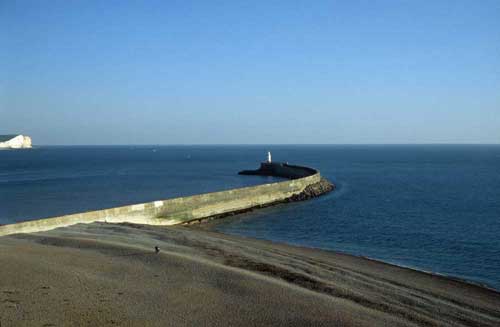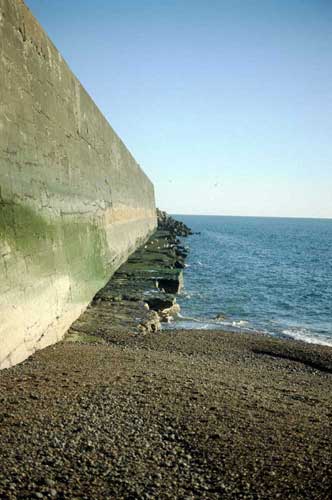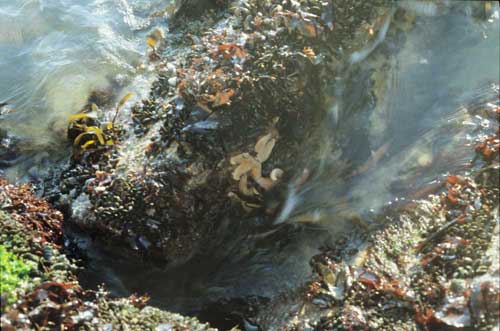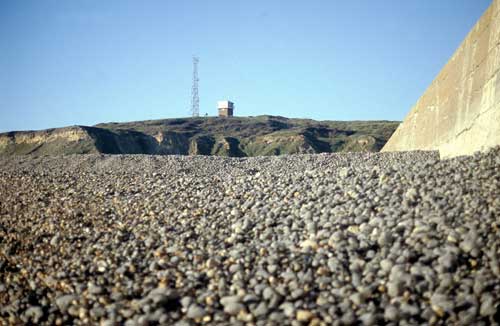Newhaven Harbour Arm extends 700m SSE, starting at Lat N50°:46':492 (50.780203) ; Long (WGS84) E0°:03':092 (0.052401) ; Grid Reference TV447998
to Lat N50°:46'34" (50.776156); Long (WGS84) E0°:03':27" (0.057543) ; LR TV451994.
It was constructed in 1890 and is now showing signs of its age and has had to be closed to public access through health and safety considerations. Fishermen used to use this extensively which made diving more interesting. Old line is still commonly found together with fishing weights and hooks. In addition pieces of nets, ropes etc are present entangled amongst the wave protective concrete blocks. Potting occurs so look out for potting ropes. A live webcam showing the area and details can be found at Newhaven Webcam
, but this is sometimes out of action.

Parking is easy, but any diver must be fairly fit to negotiate the 100m plus hike over undulating dunes of shingle which can be quite steep, particularly at low tide! These can make returning to the beach interesting when their are large waves! - the 'beached-whale' approach.
Initially the seabed is shingle over which sand eels and other fish can be seen at certain times of the year. This leads onto areas of shallow chalk gullies that may or may not be filled with dead seaweed, silt and other debris (I lost a torch amongst this!). Following the wall takes you to some intertidal fringe concrete boulders with a covering of kelps and red seaweeds. These lead onto the large subliteral concrete 'sacs' and cast blocks used to protect the wall against wave action.
The concrete blocks provide a great variety of places for life to live which means that a huge range of organisms can be found at different depths. As you go further along the harbour arm their is a change in the communities of species found.

Different times of the year will also influence what is found as does the time of day. Night dives are particularly interesting. The more casual divers are about what they sees the more they will miss. Slow and close carefull examination, using good bouyancy control and little fin movement (else sediment is stirred up) the more will be revealed.
Some of the life that can be found is shown in the following images. Clicking on the images will load a larger version.
This site is constantly monitored and the data ever-growing with species be found here being added. Should ny divers find additional species or wish to send images in to add to the database, then please send them to me.
A hundred metres along the wall (which is has distances painted on it every 50 yards) and with a tidal range of over 6m depths vary. The maximum likely to be encountered is around 15m. Visibility is extremely variable, but with experience, to some extent predictable. Forget it if a SW has been blowing hard as the chalk silt from the west drops the vis to half a metre or zero. A steady northerly gives the best vis. Prolonged easterlies which blow out Seaford Bay can give sufficient vis for a dive by the arm. It is all a matter of what one is used to and willing to put up with. Good vis = 2-3m! What some would say! Well that's pretty good for a lot of inshore Sussex. For those expecting 5-15m this is a bit of a shock. Of course you can get 'exceptional' clarity. Low vis and night diving is all good training. It is shallow but do know where your buddy is - to get caught in fishing line is not fun on your own. Plenty of good compass work too - at least the coast is E-W so just go N and you hit the shore! Not S - you end up in France.
 To make the dive a bit more interesting you can either enter the water 100m W of the arm and swim out 250m curving back towards it over the chalk gullies and sandy areas, or do this on your return. Tidal currents are usually a problem, but if the tide is on the spring cycle, when it is dropping it is just that little bit harder to swim back against it, so be sensible and time your dive accordingly. Nothing worse than a long surface swim because you over-extended your air use - particularly when you can see the distance numbers painted on the arm slowly going down! Large swells can result in some bottom surge, but this is never a real problem.
To make the dive a bit more interesting you can either enter the water 100m W of the arm and swim out 250m curving back towards it over the chalk gullies and sandy areas, or do this on your return. Tidal currents are usually a problem, but if the tide is on the spring cycle, when it is dropping it is just that little bit harder to swim back against it, so be sensible and time your dive accordingly. Nothing worse than a long surface swim because you over-extended your air use - particularly when you can see the distance numbers painted on the arm slowly going down! Large swells can result in some bottom surge, but this is never a real problem.
